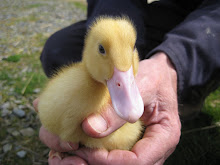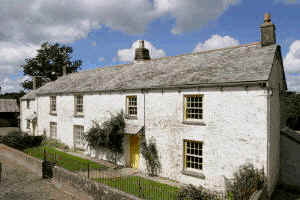 It gets very sheep focussed round here when enough lambs are ready to go to the butcher. First you bring the lambs in and sort them, checking weights and which ones are the right level of fatness. Then you ear tag the selected few, belly them out (shear off the belly fleece) and put them on clean straw in the barn to make sure they are clean and dry for the butcher. Into the trailer and off to slaughter first thing the next morning, with a comprehensive cutting list so you don't end up with chops the size of hams or joints comparable to fairy cakes. Back to the abattoir next day to pick up the offal and the salted skins, whilst the meat hangs for a further week. Home to remove the hearts and livers from the lungs and other pipework you don't want, bag it up and freeze. Jump back in the car and drive to the southern end of Dartmoor to Buckfastleigh and deliver the skins to the tannery.
It gets very sheep focussed round here when enough lambs are ready to go to the butcher. First you bring the lambs in and sort them, checking weights and which ones are the right level of fatness. Then you ear tag the selected few, belly them out (shear off the belly fleece) and put them on clean straw in the barn to make sure they are clean and dry for the butcher. Into the trailer and off to slaughter first thing the next morning, with a comprehensive cutting list so you don't end up with chops the size of hams or joints comparable to fairy cakes. Back to the abattoir next day to pick up the offal and the salted skins, whilst the meat hangs for a further week. Home to remove the hearts and livers from the lungs and other pipework you don't want, bag it up and freeze. Jump back in the car and drive to the southern end of Dartmoor to Buckfastleigh and deliver the skins to the tannery.That was a real bonus. After a dozen years of sheep keeping I have never had the skins cured before, but these days I'm determined to make use of every bit of the animal. I emailed the tannery who then looked at our farm website, said flattering things and offered me a tour. Well, it was fascinating. The place looked like an ancient distillery, what with all those huge wooden vats. Just ten people work in the three storey warehouse, and it's a physically demanding and highly skilled craft. I saw every machine, every nook and cranny, each process and their results.
 The vats where the skins are washed in clean Dart river water, soaped and steamed, pickled in chromium. The machines that remove any flesh, fat and other undesirables. The huge spin dryer, superheated iron and the dragon machine - well it looked like a dragon to me - that with the aid of a brave man leaning into the works to manhandle each skin, softens them after they have become a little hard during the various processes. There were white skins, black skins, Jacobs and curly coated Lincolnshire long wools, these latter being dyed black and used as numnahs for the Horse Guards. The natural colours and variations were glorious, which is more than can be said for the eyesmacking Barbie pink, fire engine red and optimistic sky blues stored in a separate area so, I like to think, not to offend the eye of the workers.
The vats where the skins are washed in clean Dart river water, soaped and steamed, pickled in chromium. The machines that remove any flesh, fat and other undesirables. The huge spin dryer, superheated iron and the dragon machine - well it looked like a dragon to me - that with the aid of a brave man leaning into the works to manhandle each skin, softens them after they have become a little hard during the various processes. There were white skins, black skins, Jacobs and curly coated Lincolnshire long wools, these latter being dyed black and used as numnahs for the Horse Guards. The natural colours and variations were glorious, which is more than can be said for the eyesmacking Barbie pink, fire engine red and optimistic sky blues stored in a separate area so, I like to think, not to offend the eye of the workers.It's a tactile trade - the finger tips can't lie about the suppleness or brittleness of the goods. As I was escorted round, my guide couldn't help stroke each stack of fleece, and there were many, all caressed knowingly as he passed.
I have high hopes of my badger fleeces (that's them above), with their creamy fleece and black border. I pick them up in about six weeks time.

















6 comments:
I think I've been to this tannery to buy some leather, but unlike you, was not lucky enough to get the conducted tour. I love finding out how things are done behind the scenes.
M'ear - I didn't see any retail outlet but perhaps there was one in the town itself - I'll find out. As a kid I always wanted to see how Smarties were made.
Didn't tanneries used to use urine to treat the skins?
what will you do with them?
WW - I think you're right - not now though, or at least, not there! All I knew about tanneries was gleaned from reading Suskind's Perfume.
CIG - sell them! The sheep have to pay their way somehow.
It's really interesting learning what goes on behind the scenes with things like butchery and tanning. Sort of like rural Fred Dibnah. I've been living in the Yorkshire Dales national park for six months now and I reckon I can just about tell a texel from a Swaledale and I definitely know what "hefted" means now!
Post a Comment